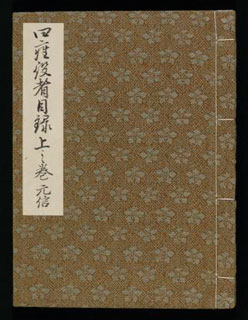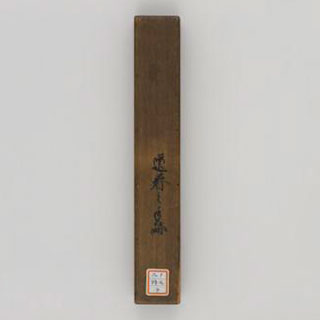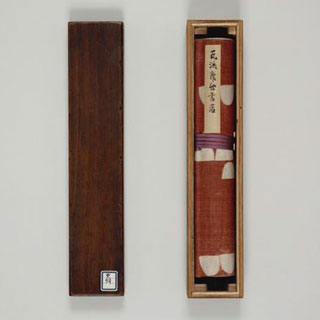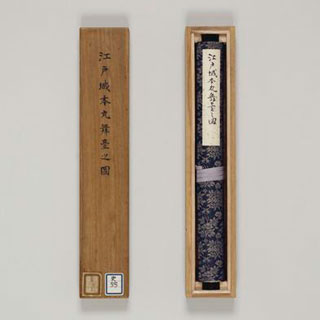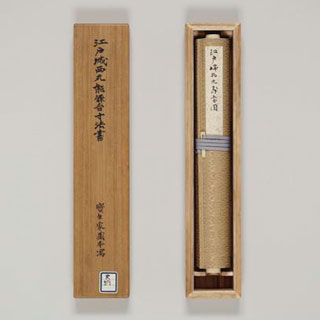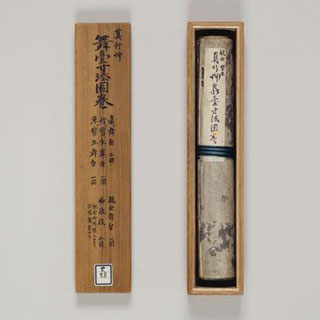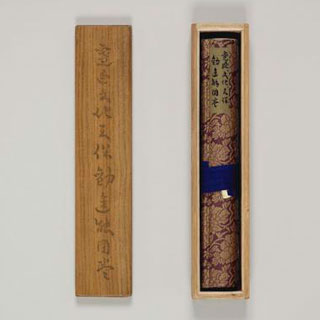Historical Materials
While chant books, treatises, and tsuke are for those performing nō, materials outside of practical purpose are also significant to the history of nō as a whole. This category includes materials that are of use to, or written by, the people engaged with nō—such as programs, diaries, biographies of performers, and blueprints of the nō stage. There are also documents unique to nō as an official ceremonial performing art with a rigid hierarchy; for example, letters of pledges were sent from disciples to their masters on the occasion of transmitting special knowledge. Also, each nō troupe had to submit official documents called kakiage that recorded the troupe’s family lineage and repertoire to the Edo Shogunate (17th-19th century). Such historical documents indicate the vast possibilities of nō studies beyond the literary analysis of plays.
-
- Title:
- Catalog of the Performers of the Four Troupes (2 vols.)
- Title (jp):
- Yoza yakusha mokuroku (jō, ge) 四座役者目録 上・下
- Description:
- 28.2 x 21.3 cm, originally a karitojibon (“book with temporary binding”). Written by Kanze Motonobu (1606-1666), a shoulder drum player of the Kanze troupe. This is a valuable catalog of Muromachi- to early Edo-period performers (nō actors, musicians, and kyōgen actors) belonging to four troupes (Kanze, Konparu, Hōshō, Kongō) and their branch troupe members. Motonobu lists the members according to troupe and records their family lineage, artistic transmission (who received teachings from whom), and episodes or characteristics of each person’s performance. According to the colophon, Motonobu completed the catalog’s volumes in 1646 (Shōhō 3) and in 1653 (Jō’ō 2), with many revisions between them.
- Collection name:
- Kanze Shinkurō Family Collection
- Volume:
- 2
- View all
-
- Title:
- Inscription for the Portrait of Kanze Kojirō Nobumitsu (colophon by Hayashi Dōshun, Kan’ei 18)
- Title (jp):
- Kan’ei 18-nen Hayashi Dōshun okugaki Kanze Kojirō Nobumitsu gazō san 寛永十八年林道春奥書観世小次郎信光画像讃
- Description:
- Handscroll, paper height 24.5 cm. Hayashi Dōshun (a.k.a. Razan, 1583-1657) was an esteemed Neo-Confucian scholar who served for four Edo shoguns. On the request of Kanze Shigenari (1601-1658), Dōshun copied and annotated the inscription attached to the portrait of Kanze Kojirō Nobumitsu (1451?-1516), which was originally written by the Zen monk Gichiku (a.k.a. Keijo Shūrin, 1440-1518).
- Collection name:
- Kanze Shinkurō Family Collection
- Volume:
- 1
-
- Title:
- Blueprint of the Zeze Castle Nō Stage
- Title (jp):
- Zeze-jō nōbutai sunpōsho 膳所城能舞台寸法書
- Description:
- Handscroll, paper height 29.7 cm. The nō stage of Zeze castle in Shiga Prefecture was built in the 11th month of 1701 (Genroku 14), and its first performance was held on the 16th day of the 12th month of the same year. This handscroll records the stage’s detailed dimensions, designs, and construction procedures.
- Collection name:
- Hosei University Kōzan Collection
- Volume:
- 1
-
- Title:
- Drawings of the Edo Castle Nō Stage, Main Hall
- Title (jp):
- Edo-jō honmaru butai no zu 江戸城本丸舞台之図
- Description:
- Handscroll, paper height 27.1 cm. The scroll records the floor plan and the front view of the Edo Castle’s main stage used for official ceremonial performances. The drawing also includes simple notes of the stage’s dimensions.
- Collection name:
- Hosei University Kōzan Collection
- Volume:
- 1
-
- Title:
- Blueprint of the Edo Castle Nō Stage, West Hall
- Title (jp):
- Edo-jō nishinomaru nōbutai sunpōsho 江戸城西丸能舞台寸法書
- Description:
- Handscroll, paper height 26.3 cm. While the Edo Castle’s Main Hall (honmaru) was the official space for the shogunate’s administration, the West Hall (nishinomaru) was more private, used as a living space for the retired shogun or the heir of the shogun. That a nō stage was constructed even for such a private space shows how the Edo Shogunate valued nō not only as official ceremonial art but also as daily entertainment. The scroll records the dimensions, floor plan, and front view of the stage, as well as drawings of metal parts necessary for the stage, as relayed by the head (iemoto) of the Hōshō school.
- Collection name:
- Hosei University Kōzan Collection
- Volume:
- 1
-
- Title:
- Blueprint of the Nō Stages of Kanze, Hōshō, and Izumi-dono
- Title (jp):
- Kanze Hōshō Izumi-dono nōbutai sunpōsho 観世・宝生・和泉殿能舞台寸法書
- Description:
- Handscroll, paper height 27.6 cm. This blueprint details the front view and floor plan of four types of stages: shinbutai, Kanze style, Hōshō style, and Izumi style which, according to the scroll, is modeled after a warrior’s residence. At the end of the scroll there are also six tips for construction, such as where to drive a metal ring into a pillar.
- Collection name:
- Hosei University Kōzan Collection
- Volume:
- 1
-
- Title:
- Picture Scroll of Kanjin Nō in the Kan’en, Bunka, and Tempō Eras
- Title (jp):
- Kan’en Bunka Tenpō Kanjin-nō zukan 寛延・文化・天保勧進能図巻
- Description:
- Handscroll, paper height 26.5 cm. The scroll is a detailed record of kanjin nō (“fundraising performances”) allowed to each iemoto (“head”) of the Kanze troupe, in 1750 (Kan’en 3), 1816 (Bunka 13), and 1831 (Tenpō 2). It includes maps of the venues, (partial or full) programs and lists of members who attended each performance, and notices circulated among the members. Kanjin nō originally started as a temporary event for the purpose of raising funds to build or repair temple buildings, bridges, or roads. However, kanjin nō lost its original purpose of contributing to the community’s infrastructure and gradually became an authoritative event permitted to the heads of the troupes by the shogun. The performance usually lasted for multiple days—25 days for the 1831 performance for example—and the troupes were able to earn huge amounts of money.
- Collection name:
- Hosei University Kōzan Collection
- Volume:
- 1

